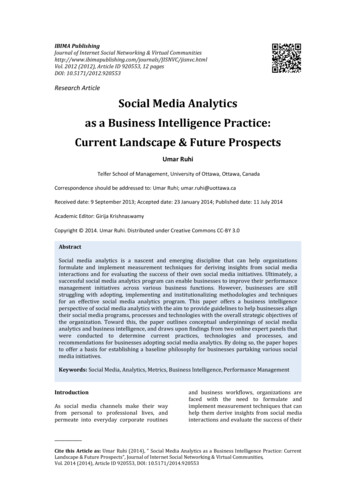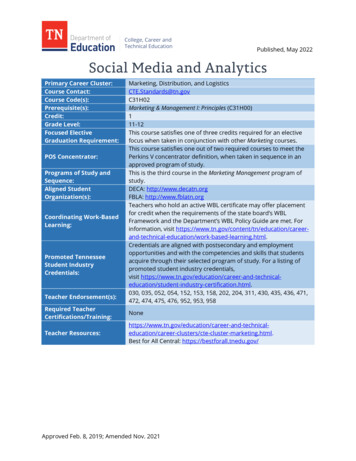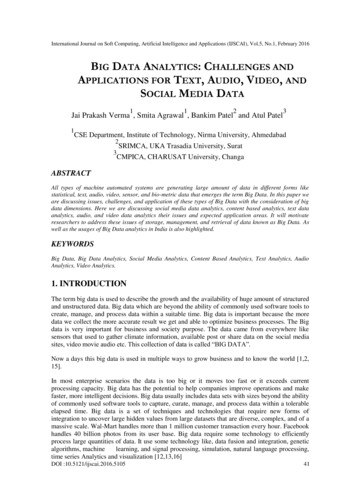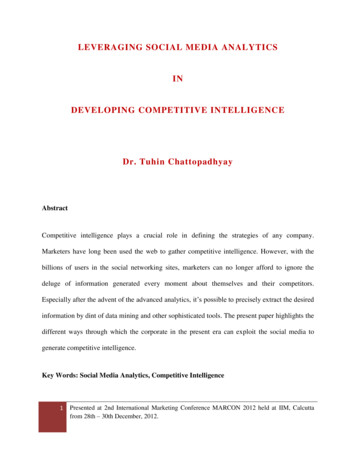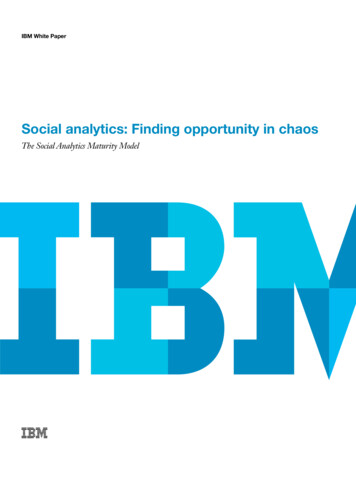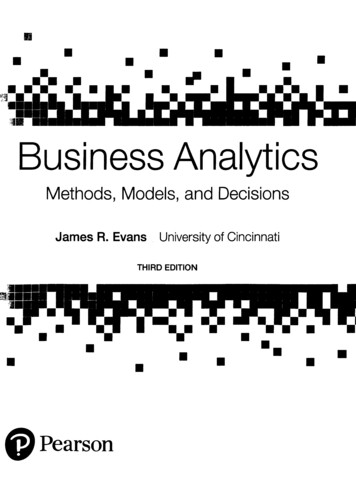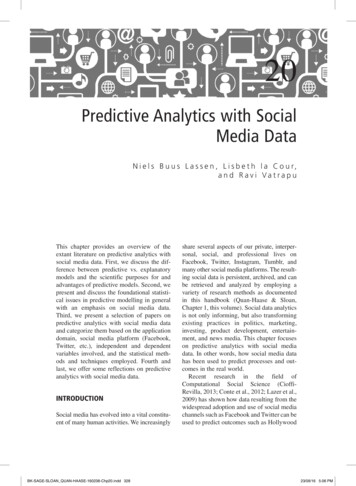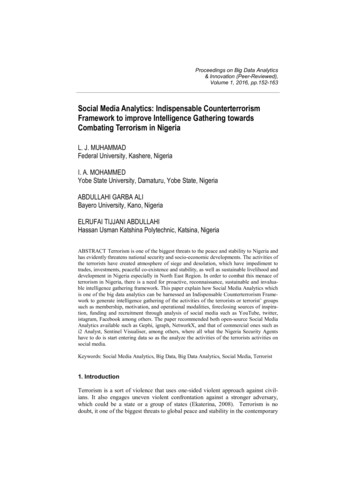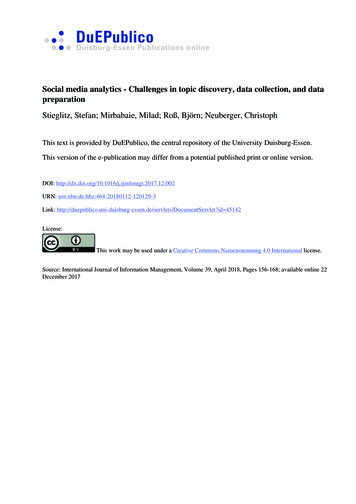
Transcription
Social media analytics - Challenges in topic discovery, data collection, and datapreparationStieglitz, Stefan; Mirbabaie, Milad; Roß, Björn; Neuberger, ChristophThis text is provided by DuEPublico, the central repository of the University Duisburg-Essen.This version of the e-publication may differ from a potential published print or online version.DOI: RN: urn:nbn:de:hbz:464-20180112-120129-3Link: ocumentServlet?id 45142License:This work may be used under a Creative Commons Namensnennung 4.0 International license.Source: International Journal of Information Management, Volume 39, April 2018, Pages 156-168; available online 22December 2017
International Journal of Information Management 39 (2018) 156–168Contents lists available at ScienceDirectInternational Journal of Information Managementjournal homepage: www.elsevier.com/locate/ijinfomgtSocial media analytics – Challenges in topic discovery, data collection, anddata preparationT⁎Stefan Stieglitza, , Milad Mirbabaiea, Björn Rossa, Christoph NeubergerbabUniversity of Duisburg-Essen, Forsthausweg 2, 47057 Duisburg, GermanyLudwig-Maximilians-Universität München, Oettingenstraße 67, 80538 München, GermanyA R T I C L E I N F OA B S T R A C TKeywords:Social media analyticsSocial mediaInformation systemsBig dataSince an ever-increasing part of the population makes use of social media in their day-to-day lives, social mediadata is being analysed in many different disciplines. The social media analytics process involves four distinctsteps, data discovery, collection, preparation, and analysis. While there is a great deal of literature on thechallenges and difficulties involving specific data analysis methods, there hardly exists research on the stages ofdata discovery, collection, and preparation. To address this gap, we conducted an extended and structuredliterature analysis through which we identified challenges addressed and solutions proposed. The literaturesearch revealed that the volume of data was most often cited as a challenge by researchers. In contrast, othercategories have received less attention. Based on the results of the literature search, we discuss the most important challenges for researchers and present potential solutions. The findings are used to extend an existingframework on social media analytics. The article provides benefits for researchers and practitioners who wish tocollect and analyse social media data.1. IntroductionSocial media has evolved over the last decade to become an important driver for acquiring and spreading information in differentdomains, such as business (Beier & Wagner, 2016), entertainment(Shen, Hock Chuan, & Cheng, 2016), science (Chen & Zhang, 2016),crisis management (Hiltz, Diaz, & Mark, 2011; Stieglitz, Bunker,Mirbabaie, & Ehnis, 2017a) and politics (Stieglitz & Dang-Xuan, 2013).One reason for the popularity of social media is the opportunity to receive or create and share public messages at low costs and ubiquitously.The enormous growth of social media usage has led to an increasingaccumulation of data, which has been termed Social Media Big Data.Social media platforms offer many possibilities of data formats, including textual data, pictures, videos, sounds, and geolocations. Generally, this data can be divided into unstructured data and structureddata (Baars & Kemper, 2008). In social networks, the textual content isan example of unstructured data, while the friend/follower relationshipis an example of structured data.The growth of social media usage opens up new opportunities foranalysing several aspects of, and patterns in communication. For example, social media data can be analysed to gain insights into issues,trends, influential actors and other kinds of information. Golder andMacy (2011) analysed Twitter data to study how people’s mood⁎changes with time of day, weekday and season. In the field of Information Systems (IS), social media data is used to study questionssuch as the influence of network position on information diffusion(Susarla, Oh, & Tan, 2012).Many existing research papers are isolated case studies (Kim, Choi,& Natali, 2016; Li & Huang, 2014; Oh, Hu, & Yang, 2016) that collect alarge data set during a specific time frame on a specific subject andanalyse it quantitatively. Despite the variety of disciplines such projectscan be found in, they have much in common. The steps necessary togain useful information or even knowledge out of social media are oftensimilar. Therefore, the field of “Social Media Analytics” aims to combine, extend, and adapt methods for the analysis of social media data(Stieglitz, Dang-Xuan, Bruns, & Neuberger, 2014). It has gained considerable attention and subsequently acceptance in academic research,but there is still a lack of comprehensive discussions of social mediaanalytics, and of general models and approaches. Aral, Dellarocas, andGodes (2013) presented a framework to organise social media research,and van Osch and Coursaris (2013) proposed a framework and researchagenda explicitly limited to organisational social media. Both frameworks are geared towards classifying areas of research and, by extension, research questions, not methods to address these questions. Whilesuch frameworks are useful to decide what to research, and to locateindividual projects within a larger context, they do not offer guidanceCorresponding author.E-mail address: stefan.stieglitz@uni-due.de (S. 7.12.002Received 23 October 2017; Accepted 1 December 20170268-4012/ 2017 The Authors. Published by Elsevier Ltd. This is an open access article under the CC BY license (http://creativecommons.org/licenses/BY/4.0/).
International Journal of Information Management 39 (2018) 156–168S. Stieglitz et al.Despite the large variety of platforms, some characteristics arecommon to many of them. Because of the amount of the content produced daily and the number of active users on the platforms, organisations are motivated to understand which issues and trends evolve toidentify risks and chances in the communication and derive usefulimplications. Besides the amount of content, it is also relevant for organisations to understand who creates the content and which actors arethe most influential drivers in the communication. Both businesses andnon-profit organisations seek to collect the data produced by the crowdin order to gain insights into mass communication. The data is oftencollected with tools which communicate with the respective API of thesocial media platform, if one exists, and crawl the data.The term “Social Media Analytics” has gained a great deal of attention. It is defined as “an emerging interdisciplinary research field thataims on combining, extending, and adapting methods for analysis of socialmedia data” (Zeng, Chen, Lusch, & Li, 2010). Whilst the perspective onthe system is one important aspect, another aspect is the perspective onthe users who create the content. Research that adopts this perspectiveexplores different roles in the communication and the effects a respective role can have on the communication and the diffusion of information (Stieglitz et al., 2017c). Influencers or opinion leaders, forexample, can be identified through a social network analysis, and byexamining their follower network, one can reveal the reach of such anindividual (Mirbabaie, Ehnis, Stieglitz, & Bunker, 2014; Mirbabaie &Zapatka, 2017). Furthermore, the behaviour of the roles is examined inorder to understand the causes of a key role in the network and theeffects it has on the overall network (Bhattacharya, Phan, & Airoldi,2015; Kefi, Mlaiki, & Kalika, 2015; Mirbabaie et al., 2014; Zhang, Zhao,Lu, & Yang, 2016). Companies such as media agencies have recognisedthe importance of influencers and use them e.g. for product placement.Furthermore, the analysis of social media content evolved in the lastfew years to one of the main research purposes in Information Systems.One research goal might be to identify and analyse the informationdiffusion (Liu, 2015; Zhang & Zhang, 2016).Among others, three domains in which social media is importantand generates visible benefits are 1) in businesses, in 2) crisis communication, mainly in disaster management, and in 3) journalism andpolitical communication.In one of the main areas of social media analytics, businesses makeuse of social media data, for several purposes (Kleindienst, Pfleger, &Schoch, 2015). Social media data can be useful for detecting new trendsin the communication or issues which could involve uncontrollable badpublicity (Bi, Zheng, & Liu, 2014). Social media is also used as achannel to communicate with customers (Griffiths & McLean, 2015;Pletikosa Cvijikj et al., 2013). For supporting decision-making processes, companies make use of social media reports, created ex post andbased on predefined key performance indicators, or they make use of adashboard for getting on-going analyses based on real-time socialmedia data (Tsou et al., 2015). Social Media is also used for productplacement (Liu, Chou, & Liao, 2015) in the social web.Crisis communication research is an example of a field where socialmedia data has had an impact. Social media is often used as a channelfor emergency management agencies to inform people in an affectedarea on the current status of the respective crisis or how to behave (Liu,2015). Social media data in the context of crisis communication canalso be analysed to gain additional, previously unknown information, ifvolunteers e.g. take pictures or videos and spread the information intothe crowd. Collected social media data can be also analysed for detecting a specific location or area where the crisis occurs. By analysingGPS data if it is included in the data or by applying the method ofNamed Entity Recognition the location could be also derived from thetext (Alsudais & Corso, 2015; Bendler, Ratku, & Neumann, 2014;Mirbabaie, Tschampel, & Stieglitz, 2016). The spread of a disease canbe monitored by mining emotional tweets (Ji, Chun, Wei, & Geller,2015). Especially for Emergency Management Agencies, it is importantto understand the communication behaviour and the current statuson how to carry out the research, and which challenges might arise. Ofcourse, there is also research that discusses challenges researchers facewhen employing specific methods for analysing social media data, suchas social network analysis (Kane, Alavi, Labianca, & Borgatti, 2014) oropinion mining (Maynard, Bontcheva, & Rout, 2012), and there areliterature reviews focused on specific goals such as the identification ofusers who are influential offline (Cossu, Labatut, & Dugué, 2016) or onspecific topics such as social bots (Stieglitz, Brachten, Ross, & Jung,2017b). Yet social media analytics consists of several steps, of whichdata analysis is only one. Before the data can be analysed, they have tobe discovered, collected, and prepared. An overview of the challengesof social media analytics is needed to be able to manage the complexityof conducting social media analytics.We therefore carried out a systematic literature review, arguing thatthe complexity of these equally important steps has not yet been adequately covered in research, and there are no widely accepted standardson how to proceed within each of the steps. We explicitly focused onpapers that deal with the challenges researchers face when discoveringtopics, and when collecting and preparing social media data for analysis, regardless of the method they later use during the analysis.Our paper focuses on the following research question: RQ: What challenges do researchers face when discovering topics,collecting and preparing social media data for further analyses?The answers to this question will help researchers who have littleexperience with the analysis of social media data, and still be useful forthose who are experienced. Newcomers to the field will find the overview of common challenges and proposed solutions useful, so thatdifficulties can be considered before they arise, when setting up theresearch design, instead of encountering problems in an advancedphase of the research. Experienced researchers will get a bird’s eye viewof the existing research, which helps identify areas that may need further investigation and challenges that have not been addressed adequately yet.The remainder of our paper proceeds as follows: first we provide astatus quo of the literature on social media analytics and highlight thetheoretical background for our article afterwards. Second, we describeour research design and highlight our findings afterwards. Third, wediscuss our results, point out their impact, and discuss a model for social media analytics. Finally, we conclude our article and derive aspectsfor further research.2. Theoretical backgroundThe interdisciplinary research field of social media analytics (SMA)deals with methods of analysing social media data. Researchers havedivided the analytics process into several steps. We use the steps ofdiscovery, collection, preparation, and analysis, which we adapted fromStieglitz et al. (2014). The particular challenges of social media data,however, have not been addressed comprehensively in the SMA literature. To be able to classify these challenges, we draw on theory fromthe big data literature instead. In particular, we use the four V’s: volume, velocity, variety, and veracity.2.1. Social media analyticsSince the rise of social media usage in the last decade, people havebeen seeking to gain information from the crowd as an additionalsource to traditional media. We use the term social media to refer to“Internet-based applications that build on the ideological and technological foundations of Web 2.0”, where Web 2.0 means that “contentand applications are no longer created and published by individuals,but instead are continuously modified by all users in a participatory andcollaborative fashion” (Kaplan & Haenlein, 2010). Because of the broaddefinition of social media, its application purposes are manifold.157
International Journal of Information Management 39 (2018) 156–168S. Stieglitz et al.We adapt their framework, adding a discovery phase that comesbefore the tracking phase, for the following reasons. The frameworkwas originally developed in the context of political communication. Inprinciple, it can easily be adapted for other research domains. The goalsand analysis methods might be different, but the process is essentiallythe same. The researchers still need to take the same decisions regarding data sources, approaches, software architecture and data storage. In politics, it is often known beforehand which topics should betracked, e.g. the prevailing sentiment surrounding a political party. In amore general context the topics might not be known a priori, and haveto be discovered first. Even when the topic on which data will be collected, such as a crisis situation, is already known, these methods canhelp identify the keywords and hashtags frequently used to talk aboutthis topic. When employed as a preliminary step, this can help researchers achieve better coverage of a topic than would have beenpossible with terms defined a priori. Additionally, recent research hasidentified challenges commonly encountered in topic discovery(Chinnov, Kerschke, Meske, Stieglitz, & Trautmann, 2015). This suggests that the addition of this step and its explicit inclusion in a literature review results in a more comprehensive coverage of challenges.This results in the following four-step framework:through social media, to be able to react faster and more efficiently.Furthermore, such agencies are also able to make use of the benefits ofreaching a crowd through social media and diffuse relevant and lifesaving information in their channels (Gill, Alam, & Eustace, 2014; vanGorp, Pogrebnyakov, & Maldonado, 2015).Finally, social media platforms have been established in recent yearsas sources of data on political communication and for journalism.People debate on current issues and further actions of politicians anddiscuss the consequences. Social media analytics examines, for example, factors that influence political participation (Johannessen &Følstad, 2014; Meth, Lee, & Yang, 2015). Political parties and governments use social media as a channel to communicate with users, toreach a broader audience, in order to gain more followers on theirpolitical opinions (Blegind & Dyrby, 2013; Hofmann, 2014; Jungherr,Schoen, & Jürgens, 2016). People express their scepticism, fury, overallsatisfaction or propose changes in social media. Through conductingsocial media analytics, governments and political parties are aiming togain insights from the communication for deriving useful strategies forthe next period of elections (Nulty, Theocharis, Popa, Parnet, & Benoit,2016; Vaccari et al., 2013).However, social media data can also have negative side effects(Wendling, Radisch, & Jacobzone, 2013). This has been recently labelled as “the dark side of social media” (Jalonen & Jussila, 2016;Kalhour & Ng, 2016; Payton & Conley, 2014). Rumours and false information could have a negative influence on the behaviour of othersocial media users. Therefore it becomes necessary to identify misinformation (Li, Sakamoto, & Chen, 2014; Wang, Ding, & Yang, 2014),rumours and fake news (Qin, Cai, & Wangchen, 2015), and the overallcredibility of a user (Yu & Zou, 2015). Therefore, mechanisms areneeded for detecting these categories of content. Another aspect is theusage of spam in social media data, which is not related to the topic andrepresents e.g. advertisement. Spam increases the amount of data andmakes the analyses more difficult.Overall, it can be stated that social media analytics is a highlycomplex process with different aspects regarding the respective application domain and the use of different methods. It is therefore usefuland necessary to standardise this phenomenon to a process model,considering each step. Discovery: The “uncovering of latent(Chinnov et al., 2015) Tracking: This step involves decisions structures and patterns”on the data source (e.g.Twitter, Facebook), approach, method and output. A detailed subdivision of this step can be found in Stieglitz et al. (2014). In severalstudies the completeness of different Twitter sources was compared(Driscoll & Walker, 2014; Morstatter, Pfeffer, & Liu, 2014;Morstatter, Pfeffer, Liu, & Carley, 2013).Preparation: Beyond this, the original framework does not elaborateon the preparation steps necessary.Analysis: Depending on the purpose there are several methodsavailable, including social network analysis and opinion mining.2.3. Types of challenges in big data analyticsAs shown above, the existing SMA literature elaborates on the stepsinvolved to some extent. However, to our knowledge, there is nocomprehensive discussion of the challenges involved in these steps. Tofill this gap, we draw on the literature on “big data”. It can be arguedthat social media data shares many characteristics of “big” data, a termthat encompasses data obtained from vastly different sources and invery different disciplines. It also includes nucleotide and protein sequences stored in massive bioinformatics databases (Howe et al., 2008)and weather and radar data used to predict flight arrival times (McAfee& Brynjolfsson, 2012). The two streams of research have much incommon. Discussions of social media data are commonly found inpublications on big data (Cao, Basoglu et al., 2015; McAfee &Brynjolfsson, 2012), and social media researchers frequently refer tothe big data literature. This has been called “social big data” (Guellil &Boukhalfa, 2015) or “social media big data” (Lynn et al., 2015).The notion that today's “big” data poses new challenges is widelyacknowledged in various fields. The key factors by which this newphenomenon differs from traditional analytics can be summarised asfollows:2.2. Steps of social media analyticsTo explicate this process, researchers have developed frameworksthat create a common basis for conducting social media analytics. Aralet al. (2013) describe research opportunities of social media analyticsand propose a research framework for understanding the relationshipsamong society, business, and social media. Their framework consists offour types of social media-related activities, and three levels of analysisthat researchers may focus on when examining these activities. Similarly, in a review of the literature on organisational social media, vanOsch and Coursaris (van Osch & Coursaris, 2013) classified relevantstudies according the artefact, actor and activity they examined.However, few research articles consider the steps of social mediaanalytics. Such frameworks take the form of process models. Fan andGordon (2014) propose a process for social media analytics consistingof three steps “capture”, “understand”, and “present”. The authors statethat the step of capture consists of gathering the data and preprocessingit, whereas pertinent information is extracted from the data in this step.Afterwards, noisy information, if existing in the data, should be removed. However, the core of this step consists of applying a key technique, such as a sentiment analysis or social network analysis, for understanding the data. In the last step the findings should be summarisedand presented (Fan & Gordon, 2014). Stieglitz et al. (2014) also proposea framework for social media analytics (SMA), which is the most accepted one in information systems, based on the citations of the paperin IS literature. The authors describe the SMA process as consisting ofthree steps (see Fig. 1). volume, the storage space required velocity, the speed of data creation coupled with the advantagegained from analysing the data in real time variety, the fact that data takes many different forms. It is oftenunstructured or its structure is specific to the data source, and veracity, uncertainty especially with regard to data quality.The first three of these “four V’s” were proposed by McAfee andBrynjolfsson (2012). Several other V’s have been proposed in addition.158
International Journal of Information Management 39 (2018) 156–168S. Stieglitz et al.Fig. 1. The Social Media Analytics Framework(Stieglitz et al., 2014; Stieglitz & Dang-Xuan, 2013).determine quantitatively which types of problems are the most frequent, and which types of problems the proposed solutions address.Veracity is frequently used. Some researchers use it only to refer to information security issues such as data integrity and authenticity(Demchenko, Grosso, Laat, & Membrey, 2013; Kepner et al., 2014).Others use a broader definition similar to the one given above (Artikis,Etzion, Feldman, & Fournier, 2012; Saha & Srivastava, 2014).Lukoianova and Rubin (2014) define the three dimensions of veracityas objectivity, truthfulness, and credibility. Another “V” sometimesproposed in the context of business analytics is value (Yin & Kaynak,2015), which refers to the financial benefits generated by big data foran organisation. In the context of academic research, it is of coursecrucial that the research promises to be of value, but this is not atechnical or methodological challenge.Clearly the first four V’s correspond to immediate technical challenges. For example, when the data takes up so much physical spacethat it does not fit into memory, many algorithms run considerablyslower. The real-time nature and variety of the data directly influencearchitectural choices. boyd and Crawford (2012) argue that the use ofbig data in science raises methodological questions in addition to thetechnical ones. For example, data errors abound and must be dealt with,social media users are not representative of the general population, andpublishing Facebook data is morally questionable when the data caneasily be linked to individuals. Their concerns about ethics and accessbarriers are related to steps of the research process that are outside thescope of this article. Yet the data's lack of accuracy, representativenessand context is affected by the chosen data source and method of extraction. These issues fall under the broader definition of veracity.In social sciences veracity is the main criterion for the assessment ofbig data (Bruns, 2013; King, 2011; Lin, 2015; Mahrt & Scharkow, 2013;Shah, Cappella, & Neuman, 2015). Social media promise a completeand real-time record of “natural” user activities. Issues relating to validity and representativeness have often been discussed and explored(Diaz, Gamon, Hofman, Kiciman, & Rothschild, 2016; Jungherr et al.,2016; Ruths & Pfeffer, 2014; Tufekci, 2014). It has even been debatedand explored if SMA can replace traditional and more expensive waysof data collection such as population surveys (Diaz et al., 2016;Hargittai, 2015; Japec et al., 2015; Jungherr et al., 2016; Schober,Pasek, Guggenheim, Lampe, & Conrad, 2016). But it was also criticisedthat there is a lack of tested standard procedures for data collection(Jungherr, 2016) and a danger of data-driven, non-theoretical approaches (Kitchin, 2014). We therefore use these four V's as categoriesfor the purpose of classifying the individual difficulties faced by researchers. For example, spam and missing data both compromise theveracity of the data, and they are not likely to benefit from a techniquethat is designed to cope with its velocity. This classification allows us to3. Research designWe chose to conduct a literature review to answer our researchquestion. A review can “tackle an emerging issue that would benefit fromexposure to potential theoretical foundations” (Webster & Watson, 2002).We argue that social media analytics is such an emerging research areathat will benefit from a logical conceptualisation.Our research design therefore consists of three principal steps. First,we use the theoretical foundations laid out above as a framework inclassifying the existing research on the challenges of SMA. As Bem(1995) noted, “a coherent review emerges only from a coherent conceptualstructuring of the topic itself”. In our case, the steps of SMA and thechallenges of big data serve as this conceptual a priori structure. Thisdeductive step resulted in a rough categorisation of the articles found.In a second step, we examined the literature in more detail to identifysimilarities and differences between the individual articles. We therebydetermined how the big data challenges become apparent in the SMAsteps, and which solutions researchers have proposed. This step servesto inductively synthesise prior research and group related articles intological concepts. Finally, in the third step, we considered the largerimplications of our analysis for future research and derived an extension of the SMA framework.Our literature review follows the systematic sequential processproposed by vom Brocke et al. (2009) and vom Brocke et al. (2015).(1) First, we searched for predefined terms in the selected databasesand read the title and abstract of each of the results to determine itsrelevance. The main problem we address in this article is which challenges researchers face when discovering, collecting and preparing social media data for further analysis. The search terms were chosen inorder to identify papers from the area of social media analytics thatexplicitly mention challenges or difficulties. We expanded the searchwith other roughly synonymous search terms (see Table 1). We refinedthe search terms iteratively and formulated them so as to exclude manyirrelevant publications but include many relevant ones. For example,we did not search for mentions of individual social media such asTwitter and Facebook because our aim was to uncover challenges thatare common to many different platforms. Likewise, we limited thesearch to the title, abstract and keywords, which helped us only findarticles that treat challenges as a crucial part of their content, and donot simply mention them as an afterthought, for example, whenpointing out opportunities for future research. We considered159
International Journal of Information Management 39 (2018) 156–168S. Stieglitz et al.ones with the most incoming edges can be assumed to be seminalpublications that had a great deal of influence on the field. We determined their relevance according to the above criteria and read therelevant sections of the citing papers to determine the context they werefrequently cited in.Table 1Keywords and databases which were used for the Systematic Literature Review.Search terms(“social mediaanalytics”OR “social mediaanalysis”OR “social mediadata”OR “social mediamining”)ANDDatabasesFieldsTitle,AbstractOR problemsACM DigitalLibraryAIS ElectronicLibraryIEEE XploreOR complexity)ScienceDirect(challengesOR difficulties4. Findings4.1. Overview of the resultsThe execution of the systematic literature review, by searching forthe search terms in all combinations and in all predefined databases andconducting a backward search, resulted in 49 relevant articles.Table 3 shows the number of search results in each database. Of thearticles returned by the search query, only about one in five were relevant to the research question. Most articles either dealt with thechallenges of specific methods, such as feature extraction in machinelearning, or domains, e.g. disaster response.The classification enables us to take a closer look at the distributionof papers across categories (see Table 4). This makes it possible to examine which areas a large amount of research has been done in, andwhich ones have received less attention. This section is only intended asan overview of the current environment. We do not claim that areas inwhich less research has been done should receive more attention, because it may also simply mean that the problem is not as big as it mayseem.Challenges in the discovery step are most often due to the datavolume. More precisely, the sheer volume of data is often cited as theprimary motivation behi
In one of the main areas of social media analytics, businesses make use of social media data, for several purposes (Kleindienst, Pfleger, & Schoch, 2015). Social media data can be useful for detecting new trends in the communication or issues which could involve uncontrollable bad publicity (Bi, Zheng, & Liu, 2014). Social media is also used as a

